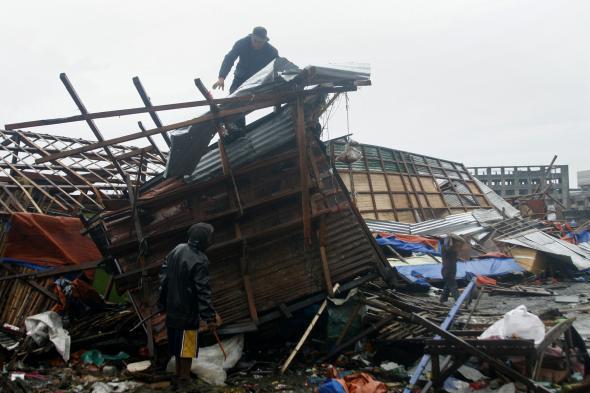The death toll from Typhoon Hagupit, which made landfall in the Philippines on Saturday night, has risen to 21. Hagupit hit as delegates from 190 countries are meeting in Lima to hammer out the elements of a global climate deal that is due to be agreed upon in Paris next year. And this isn’t the first time that a typhoon swept through the Philippines during a major climate change conference. In 2012, Typhoon Bopha hit the country at the same time as a major meeting in Doha. Last year’s Typhoon Haiyan, the strongest typhoon ever recorded, devastated the country as delegates were meeting for a U.N. climate change conference in Warsaw, galvanizing calls for wealthy countries to help the developing world cope with its effects, including more severe storms.
“Every year since 2008, typhoons have become the backdrop of the climate change conference,” Mary Ann Lucille Sering, secretary of the Philippines climate change commission, told this year’s conference. Philippine NGOs taking part in the Lima meeting are using the storm to make the case that more urgency is needed. “To us in the Philippines, we are not any more debating on whether or not the impacts of climate change are here,” one activist told the AFP.
While it’s impossible to pin responsibility for any one weather event on climate change, catastrophic typhoons do appear to be getting more frequent and rising sea levels are contributing to worsening storm surges and flooding. If storms continue to worsen, Asian countries like the Philippines may bear the brunt of the damage. A recent report from Oxfam found that 78 percent of people killed by natural disasters lived in Asia even though just 43 percent of disasters occurred there. (Asia accounts for about 60 percent of the world population.) Asia has also borne about half the economic cost of these disasters over the last 20 years.
This isn’t all because of climate change. Much of it is due to increasingly large populations living in vulnerable areas like Tacloban, the rapidly growing regional capital devastated by storm surges during Haiyan and again during the most recent storm. The large cities of Asia are particularly vulnerable to floods and storms, and according to Oxfam, “the number of people exposed to coastal flooding in Asia is expected to increase by 50 percent by 2030.” These include major agricultural areas in South and Southeast Asia. Haiyan alone may have done more than $225 million in damage to the Philippine agricultural sector.
Natural disasters are already costing the world’s second-largest economy, China, an estimated $69 billion per year, and these costs are growing along with the severity of droughts and floods.
What chance is there that a climate deal could help Asia deal with catastrophic weather events? There’s a bit more momentum than usual heading into this year’s meetings following last November’s U.S.-China emissions deal and several recent pledges from wealthy countries that have raised the U.N. Green Climate Fund, meant to help poor countries adapt to the effects of climate change, to more than $10 billion. But there are still major rifts between already-rich countries and developing countries over who bears responsibility for emissions cuts. Asia’s economic growth and reductions in poverty have been one of the great positive transformations of modern times, but going forward the weather’s going to be a problem, especially if the rest of the world doesn’t chip in to help out.
